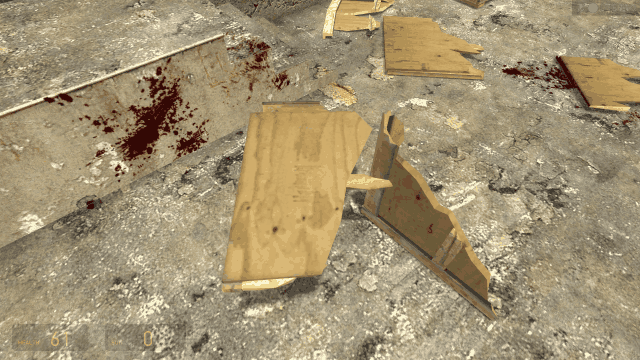I see that the pieces interpenetrate, which is distracting from the immersive realism.
You say that you are trying to mimic how half life did it, where they just disable interaction between debris.
My opinion is that back then, that was a big achievement, but it will not impressed too many people these days.
The challenge is how to make concave and yet stable and looking realistic.
The answer is that, I can may suggest an algorithm that may help.
Algorithm for Building Concave Collision Shapes Without Interpretation
The goal is to construct concave collision structures out of convex pieces in a way that guarantees no overlaps.
Initial SetupStart with the asset model.
An artist provides a set of convex collision shapes for the model.
Voronoi DecompositionIterate over all convex shapes.
For each shape, compute a Voronoi decomposition.
By construction, Voronoi cells do not overlap, so this yields a clean set of non-overlapping convex pieces.
Adjacency Graph ConstructionFrom the convex decomposition, build an adjacency structure:
For each convex piece, determine which other pieces are directly adjacent.
Store these as an array of adjacency pairs.
Interactive Chunking (Editor Tool)In the editor, when the user selects a convex piece, the tool highlights all adjacent pieces based on the adjacency graph.
after the selection of a chunk.
In code the editor groups the subset of adjacent convex pieces into a chunk.
Lemma: If all atomic convex pieces are non-overlapping, then any subset of adjacent pieces is also non-overlapping (take this as an axiom).
Chunk ConsolidationOnce a chunk is chosen:
Remove all adjacency pairs involving any piece in the chunk from that initial array of pairs.
This leaves two disjoint sets:
The selected concave chunk and form a compound debris object from this.
The remaining set of convex pieces need to be converted into array of adjacent atomic pierces.
Decomposing Remaining PiecesUse a disjoint-set algorithm (Union–Find) to partition the remaining convex pieces into connected subsets of adjacent primitives. check out Wikipedia:
https://en.wikipedia.org/wiki/Disjoint- ... _structureafter this, each resulting subset is either:
A valid concave group (to keep as-is), or
A set that may be further processed interactively.
this let you build a first level of clean debris system that is guaranteed to not overlap when breaking
Hierarchical SubsystemsThis process naturally supports hierarchical decomposition:
At a higher level, create large concave chunks.
At lower levels (e.g., for LOD), treat each chunk as a set of convex parts that can be regrouped or further subdivided.
you can add tool options, stuff like automationAfter the first layer of user-guided chunking, sub-parts can be auto-generated using heuristics (e.g., size, balance, connectivity).
This makes it trivial to produce multiple levels of concave grouping automatically.
I wanted to make the debris demo that way, but the lack of editor makes it very difficult.



